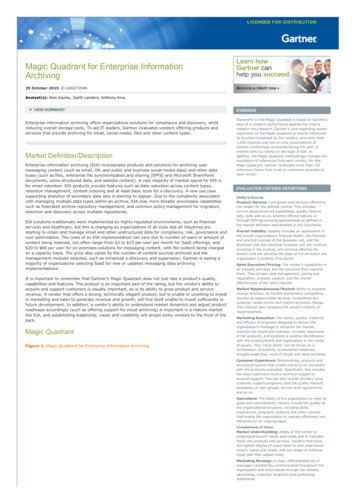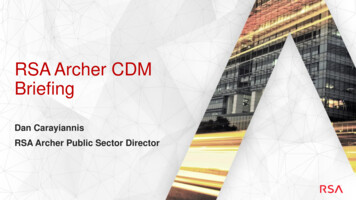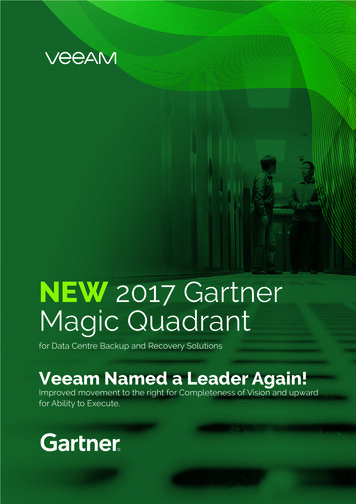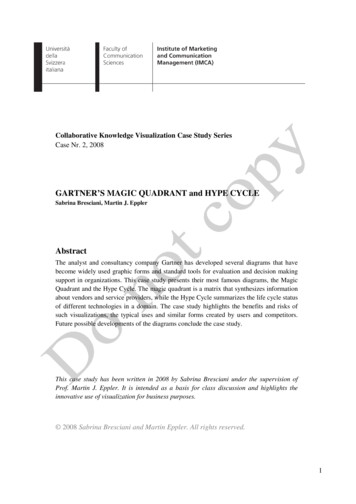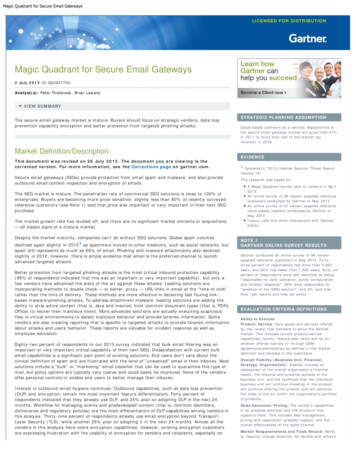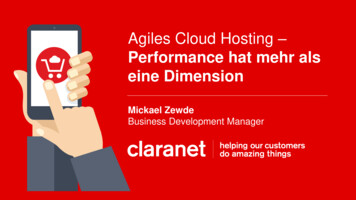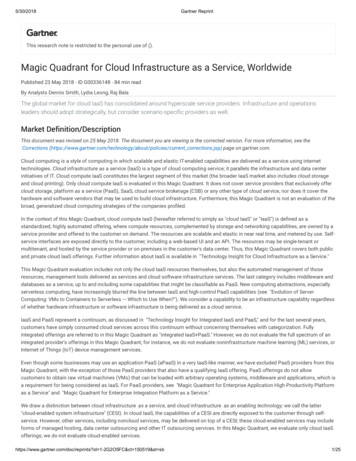
Transcription
5/30/2018Gartner ReprintThis research note is restricted to the personal use of ().Magic Quadrant for Cloud Infrastructure as a Service, WorldwidePublished 23 May 2018 - ID G00336148 - 84 min readBy Analysts Dennis Smith, Lydia Leong, Raj BalaThe global market for cloud IaaS has consolidated around hyperscale service providers. Infrastructure and operationsleaders should adopt strategically, but consider scenario-specific providers as well.Market Definition/DescriptionThis document was revised on 25 May 2018. The document you are viewing is the corrected version. For more information, see theCorrections /current corrections.jsp) page on gartner.com.Cloud computing is a style of computing in which scalable and elastic IT-enabled capabilities are delivered as a service using internettechnologies. Cloud infrastructure as a service (IaaS) is a type of cloud computing service; it parallels the infrastructure and data centerinitiatives of IT. Cloud compute IaaS constitutes the largest segment of this market (the broader IaaS market also includes cloud storageand cloud printing). Only cloud compute IaaS is evaluated in this Magic Quadrant. It does not cover service providers that exclusively offercloud storage, platform as a service (PaaS), SaaS, cloud service brokerage (CSB) or any other type of cloud service, nor does it cover thehardware and software vendors that may be used to build cloud infrastructure. Furthermore, this Magic Quadrant is not an evaluation of thebroad, generalized cloud computing strategies of the companies profiled.In the context of this Magic Quadrant, cloud compute IaaS (hereafter referred to simply as "cloud IaaS" or "IaaS") is defined as astandardized, highly automated offering, where compute resources, complemented by storage and networking capabilities, are owned by aservice provider and offered to the customer on demand. The resources are scalable and elastic in near real time, and metered by use. Selfservice interfaces are exposed directly to the customer, including a web-based UI and an API. The resources may be single-tenant ormultitenant, and hosted by the service provider or on-premises in the customer's data center. Thus, this Magic Quadrant covers both publicand private cloud IaaS offerings. Further information about IaaS is available in "Technology Insight for Cloud Infrastructure as a Service."This Magic Quadrant evaluation includes not only the cloud IaaS resources themselves, but also the automated management of thoseresources, management tools delivered as services and cloud software infrastructure services. The last category includes middleware anddatabases as a service, up to and including some capabilities that might be classifiable as PaaS. New computing abstractions, especiallyserverless computing, have increasingly blurred the line between IaaS and high-control PaaS capabilities (see "Evolution of ServerComputing: VMs to Containers to Serverless — Which to Use When?"). We consider a capability to be an infrastructure capability regardlessof whether hardware infrastructure or software infrastructure is being delivered as a cloud service.IaaS and PaaS represent a continuum, as discussed in "Technology Insight for Integrated IaaS and PaaS," and for the last several years,customers have simply consumed cloud services across this continuum without concerning themselves with categorization. Fullyintegrated offerings are referred to in this Magic Quadrant as "integrated IaaS PaaS." However, we do not evaluate the full spectrum of anintegrated provider's offerings in this Magic Quadrant; for instance, we do not evaluate noninfrastructure machine learning (ML) services, orInternet of Things (IoT) device management services.Even though some businesses may use an application PaaS (aPaaS) in a very IaaS-like manner, we have excluded PaaS providers from thisMagic Quadrant, with the exception of those PaaS providers that also have a qualifying IaaS offering. PaaS offerings do not allowcustomers to obtain raw virtual machines (VMs) that can be loaded with arbitrary operating systems, middleware and applications, which isa requirement for being considered as IaaS. For PaaS providers, see "Magic Quadrant for Enterprise Application High-Productivity Platformas a Service" and "Magic Quadrant for Enterprise Integration Platform as a Service."We draw a distinction between cloud infrastructure as a service, and cloud infrastructure as an enabling technology; we call the latter"cloud-enabled system infrastructure" (CESI). In cloud IaaS, the capabilities of a CESI are directly exposed to the customer through selfservice. However, other services, including noncloud services, may be delivered on top of a CESI; these cloud-enabled services may includeforms of managed hosting, data center outsourcing and other IT outsourcing services. In this Magic Quadrant, we evaluate only cloud IaaSofferings; we do not evaluate cloud-enabled services.https://www.gartner.com/doc/reprints?id 1-2G2O5FC&ct 150519&st sb1/25
5/30/2018Gartner ReprintGartner's clients are mainly enterprises, midmarket businesses and technology companies of all sizes, and the evaluation focuses ontypical client requirements. This Magic Quadrant covers all the common use cases for cloud IaaS, including development and testing,production environments (including those supporting mission-critical workloads) for both internal and customer-facing applications, batchcomputing (including high-performance computing [HPC]), and disaster recovery. It includes not only the hosting of single-applicationworkloads, but also the replacement of traditional enterprise data centers with cloud environments that can support a highly diverse rangeof workloads. It includes suitability for a wide range of application design patterns, including cloud-native applications, web-eraapplications and legacy enterprise applications.Customers typically exhibit a bimodal IT sourcing pattern for cloud IaaS (see "Bimodal IT: How to Be Digitally Agile Without Making aMess" and "Best Practices for Planning a Cloud Infrastructure-as-a-Service Strategy — Bimodal IT, Not Hybrid Infrastructure"). Most cloudIaaS is bought for Mode 2 agile IT, emphasizing developer productivity and business agility, but an increasing amount of cloud IaaS is beingbought for Mode 1 traditional IT, with an emphasis on cost reduction, safety and security. Infrastructure and operations (I&O) leaderstypically lead the sourcing for Mode 1 cloud needs. By contrast, sourcing for Mode 2 offerings is typically driven by enterprise architects,application development leaders and digital business leaders. This Magic Quadrant considers both sourcing patterns and their associatedcustomer behaviors and requirements.This Magic Quadrant strongly emphasizes self-service and automation in a standardized environment. It focuses on the needs ofcustomers whose primary need is self-service cloud IaaS, although this may be supplemented by a small amount of colocation ortraditional hosting. In self-service cloud IaaS, the customer retains most of the responsibility for IT operations (even if the customersubsequently chooses to outsource that responsibility via third-party managed services). Third-party managed service providers arecovered in the "Magic Quadrant for Public Cloud Infrastructure Managed Service Providers, Worldwide."Organizations that need significant customization or managed services for a single application, or that are seeking cloud IaaS as asupplement to a traditional hosting solution ("hybrid hosting"), should consult the Market Guide and Magic Quadrants for managed hostinginstead ( "Market Guide for Managed Hybrid Cloud Hosting, North America,""Magic Quadrant for Managed Hybrid Cloud Hosting, Europe"and "Magic Quadrant for Managed Hybrid Cloud Hosting, Asia/Pacific"). Organizations that want a fully custom-built solution, or managedservices with an underlying CESI, should consult the Magic Quadrants for data center outsourcing and infrastructure utility services( "Magic Quadrant for Data Center Outsourcing and Infrastructure Utility Services, North America,""Magic Quadrant for Data CenterOutsourcing and Infrastructure Utility Services, Europe" and "Magic Quadrant for Data Center Outsourcing and Infrastructure UtilityServices, Asia/Pacific").This Magic Quadrant evaluates all industrialized cloud IaaS solutions, whether public cloud (multitenant or mixed-tenancy), communitycloud (multitenant, but limited to a particular customer community), or private cloud (fully single-tenant, hosted by the provider or onpremises). It is not merely a Magic Quadrant for public cloud IaaS. To be considered industrialized, a service must be standardized acrossthe customer base; it is insufficient to use a common reference architecture. Although most of the providers in this Magic Quadrant dooffer custom private cloud IaaS, we have not considered these nonindustrialized offerings in our evaluations. Organizations that are lookingfor custom-built, custom-managed private clouds should use our Magic Quadrants for data center outsourcing and infrastructure utilityservices instead (see above).Understanding the Vendor Profiles, Strengths and CautionsCloud IaaS providers that target enterprise and midmarket customers generally offer a high-quality service, with excellent availability, goodperformance, high security and good customer support. Exceptions will be noted in this Magic Quadrant's evaluations of individualproviders. Note that, when we say "all providers," we specifically mean "all the evaluated providers included in this Magic Quadrant," not allcloud IaaS providers in general. Keep the following in mind when reading the vendor profiles: All the providers have a public cloud IaaS offering. A few also have an industrialized private cloud offering, where every customer is onstandardized infrastructure and cloud management tools, although this may or may not resemble the provider's public cloud service ineither architecture or quality. A single architecture and feature set and cross-cloud management, for both public and private cloud IaaS,make it easier for customers to combine and migrate across service models as their needs dictate. They also enable the provider to useits engineering investments more effectively. Most of the providers also offer custom private clouds. All of the providers target midmarket businesses and enterprises, as well as other companies that use technology at scale. Some of theproviders may also target small businesses and startups. Just because a provider targets a segment, however, does not necessarilymean that it is well-suited to that segment's needs. Furthermore, not all providers have the capacity to serve very large-scale customers,and some have capacity constraints in particular regions. Most of the providers are oriented toward the needs of Mode 2 agile IT. These providers typically emphasize capabilities for newapplications and a DevOps orientation, but are also capable of running legacy applications and being managed in a traditional fashion.https://www.gartner.com/doc/reprints?id 1-2G2O5FC&ct 150519&st sb2/25
5/30/2018Gartner ReprintMost providers are also capable of serving Mode 1 traditional IT, especially IT operations organizations, with an emphasis on control,governance and security. Keep in mind that a "rented virtualization" approach can be used for both new and legacy applications, but isunlikely to provide transformational benefits. All the providers offer basic cloud IaaS — compute, storage and networking resources as a service. They also offer additional value-added capabilities as well, notably cloud software infrastructure services — typically middleware and databases as a service — up to andincluding PaaS capabilities. These services, along with IT operations management (ITOM) capabilities as a service (especially DevOpsrelated services), are a vital differentiator in the market, especially for Mode 2 agile IT buyers. While all providers have both IaaS andPaaS offerings, only some offer integrated IaaS PaaS; these providers are explicitly noted. We consider an offering to be public cloud IaaS if the storage and network elements are shared; the compute can be multitenant, single-tenant or both. Private cloud IaaS uses single-tenant compute and storage, but unless the solution is on the customer's premises, thenetwork is usually still shared. All the providers claim to have high security standards. The extent of the security controls provided to customers varies significantly,though. All the providers evaluated can offer solutions that will meet common regulatory compliance needs, unless otherwise noted. Allthe providers have SSAE 16 audits for their data centers (see Note 1). Some may have security-specific third-party assessments such asISO 27001 or SOC 2 for their cloud IaaS offerings (see Note 2). Both provide a relatively high level of assurance that the providers areadhering to generally accepted practices for the security of their systems, but do not address the extent of controls offered tocustomers. Security is a shared responsibility; customers need to correctly configure controls and may need to supply additionalcontrols beyond what their provider offers. Furthermore, providers vary in their degree of transparency, although customers typicallyhave access to third-party assessment reports under a nondisclosure agreement. In general, monthly compute availability SLAs of 99.95% and higher are the norm, and they are typically higher than availability SLAs formanaged hosting. Service credits for outages in a given month are typically capped at 100% of the monthly bill, but some providers havecaps as low as 25%. This availability percentage is typically non-negotiable, as it is based on an engineering estimate of the underlyinginfrastructure reliability. Maintenance windows are normally excluded from the SLA. Some providers have a compute availability SLA that requires the customer to use compute capabilities in at least two fault domains(sometimes known as "availability zones" or the like); an SLA violation requires both fault domains to fail. Providers with an SLA of thistype are explicitly noted as having a multi-fault-domain SLA. Very few of the providers have an SLA for compute or storage performance. None of these providers oversubscribe compute or RAMresources in standard compute instances, but some may have special, less expensive instance types that do, such as "burstable"instances. Many providers have additional SLAs covering network availability and performance, customer service responsiveness and other serviceaspects. Infrastructure resources are not normally automatically replicated into multiple data centers, unless otherwise noted; customers areresponsible for their own business continuity. Some providers offer optional disaster recovery solutions. All providers offer, at minimum, per-hour metering of VMs, and some can offer shorter metering increments, which can be more cost-effective for short-term batch jobs. Providers charge on a per-VM basis, unless otherwise noted. Some of the providers are able to offer bare-metal physical servers on a dynamic basis, priced by the hour. Providers with a bare-metaloption are noted as such. All the providers offer an option for colocation, unless otherwise noted. Many customers have needs that require a small amount ofsupplemental colocation in conjunction with their cloud — most frequently for a large-scale database, but sometimes for specializednetwork equipment, software that cannot be licensed on virtualized servers, or legacy equipment. Colocation is specifically mentionedonly when a service provider actively sells colocation as a stand-alone service; a significant number of midmarket customers plan tomove into colocation and then gradually migrate into that provider's IaaS offering. If a provider does not offer colocation itself, but canmeet such needs via a partner exchange, this is explicitly noted. Some providers offer a software marketplace where software vendors specially license and package their software to run on thatprovider's cloud IaaS offering. Marketplace software can be automatically installed with a click, and can be billed through the provider.Some marketplaces also contain other third-party solutions and services.https://www.gartner.com/doc/reprints?id 1-2G2O5FC&ct 150519&st sb3/25
5/30/2018Gartner Reprint All providers offer enterprise-class support with 24/7 customer service, via phone, email and chat, along with an account manager. Mostproviders include this with their offering. Some offer a lower level of support by default, but allow customers to pay extra for enterpriseclass support. All the providers will sign contracts with customers, can invoice and can consolidate bills from multiple accounts. While some may alsooffer online sign-up and credit card billing, they recognize that enterprise buyers prefer contracts and invoices. Some will sign "zerodollar" contracts that do not commit a customer to a certain volume. Unless otherwise noted, all providers will sign the following contract addendums: a U.S. Health Insurance Portability and AccountabilityAct Business Associate Agreement (HIPAA BAA); an EU Data Protection Directive (95/46/EC) data processing agreement (DPA), whichincludes the model clauses; and an EU General Data Protection Regulation (GDPR) DPA. Some of the providers offer optional managed services on IaaS. Such providers may not offer the same type of managed services onIaaS as they do in their broader managed hosting or data center outsourcing services. Some may have managed service provider (MSP)or system integrator (SI) partners that provide managed and professional services. All the evaluated providers offer a portal, documentation, technical support, customer support and contracts in English. Some canprovide one or more of these in languages other than English. Most providers can conduct business in local languages, even if allaspects of service are English-only. All the providers are part of very large corporations or otherwise have a well-established business. However, many of the providers areundergoing significant re-evaluation of their cloud IaaS businesses. Existing and prospective customers should be aware that suchproviders may make significant changes to the strategy and direction of their cloud IaaS business. These changes may include replacingtheir current offering with a new platform, or exiting this business entirely in favor of partnering with a more successful provider.In previous years, this Magic Quadrant has provided significant technical detail on the offerings. These detailed evaluations are nowpublished in "Critical Capabilities for Public Cloud Infrastructure as a Service, Worldwide" instead.The service provider descriptions are accurate as of the time of publication. Our technical evaluation of service features took placebetween January 2018 and March 2018.Format of the Vendor DescriptionsWhen describing each provider, we first summarize the nature of the company and then provide information about its industrialized cloudIaaS offerings in the following format:Offerings: A list of the industrialized cloud IaaS offerings (both public and private) that are directly offered by the provider. Also included iscommentary on the ways in which these offerings deviate from the standard capabilities detailed in the Understanding the Vendor Profiles,Strengths and Cautions section above. We also list related capabilities of interest, such as object storage, content delivery network (CDN),aPaaS and managed services, but this is not a comprehensive listing of the provider's offerings.Locations: Cloud IaaS data center locations by country, languages that the company does business in and languages that technicalsupport can be conducted in.Provider maturity: Cloud IaaS providers vary dramatically in their level of risk — the degree to which a customer can trust them to be secure,reliable, stable businesses. We provide a three-tier maturity model in "Inform Your Cloud Service Choice With Provider Maturity," and foreach provider, we list its tier in that maturity model. Tier 1 providers are global megavendors. Tier 2 providers are engaged in a struggle forsustainability, with the largest hoping to break into the top tier. Tier 2 is divided into two categories: The Tier 2A category is composed ofestablished technology vendors, while the Tier 2B category consists of cloud-only (or cloud-primary) vendors that have grown enough to besignificant. Tier 3 providers are emerging and risky; there are none on this Magic Quadrant. We recommend that customers focus riskassessment and mitigation efforts on Tier 2 providers, which may be undesirably immature, but are more likely to be willing to offer bettercontractual terms, SLAs and pricing in order to ease customer concerns. Tier 2 providers require attentive vendor management and apotential exit strategy.Recommended mode: We note whether the vendor's offerings are likely to appeal to Mode 1 safety-and-efficiency-oriented IT, Mode 2agility-oriented IT, or both. We also note whether the offerings are likely to be useful for organizations seeking IT transformation. Thisrecommendation reflects the way that a provider goes to market, provides service and support, and designs its offerings. All suchstatements are specific to the provider's cloud IaaS offering, not the provider as a whole.https://www.gartner.com/doc/reprints?id 1-2G2O5FC&ct 150519&st sb4/25
5/30/2018Gartner ReprintRecommended uses: These are the circumstances under which we recommend the provider. These are not the only circumstances inwhich it may be a useful provider, but these are the scenarios for which, in Gartner's opinion, the provider is best-suited. For all the vendors,the recommended uses are specific to self-managed cloud IaaS. However, some of the providers also have managed services, as well asother cloud and noncloud services that may be used in conjunction with cloud IaaS. These include hybrid hosting (customers sometimesblend solutions, such as an entirely self-managed front-end web tier on public cloud IaaS, with managed hosting for the application serversand database), as well as hybrid IaaS/PaaS solutions. Even though we do not evaluate managed services, nonintegrated PaaS and the likein this Magic Quadrant, they are part of a vendor's overall value proposition and we mention them in the context of providing morecomprehensive solution recommendations.In the list of offerings, we state the basis of each provider's virtualization technology and, if relevant, its cloud infrastructure framework(CIF) — the software used to create the cloud service, such as OpenStack or VMware vCloud Director. We also state what APIs it supports— the Amazon Web Services (AWS), OpenStack and vCloud APIs are the three that have broad adoption, but many providers also have theirown unique APIs. Note that supporting one of the three common APIs does not provide assurance that a provider's service is compatiblewith a specific tool that purports to support that API; the completeness and accuracy of API implementations vary considerably.Furthermore, the use of the same underlying CIF or API compatibility does not indicate that two services are interoperable. Specifically,OpenStack-based clouds differ significantly from one another, limiting portability; the marketing hype of "no vendor lock-in" is, practicallyspeaking, untrue.For many customers, the underlying hypervisor will matter, particularly for those that intend to run commercial software on IaaS. Manyindependent software vendors (ISVs) support only VMware virtualization. Vendors that support Xen may support only Citrix XenServer, notopen-source Xen (which is often customized by IaaS providers and is likely to be different from the current open-source version). Similarly,some ISVs may support the Kernel-based Virtual Machine (KVM) hypervisor in the form of Red Hat Enterprise Virtualization, whereas manyIaaS providers use open-source KVM.For a detailed technical description of public cloud IaaS offerings, along with a use-case-focused technical evaluation, see "CriticalCapabilities for Public Cloud Infrastructure as a Service, Worldwide."We also provide a detailed list of evaluation criteria in "Evaluation Criteria for Cloud Infrastructure as a Service." We have used thosecriteria to perform in-depth assessments of several providers: see "In-Depth Assessment of Amazon Web Services IaaS, March 2018,""InDepth Assessment of Google Cloud Platform IaaS, March 2018" and "In-Depth Assessment of Microsoft Azure IaaS, March 2018."Magic QuadrantFigure 1. Magic Quadrant for Cloud Infrastructure as a Service, Worldwidehttps://www.gartner.com/doc/reprints?id 1-2G2O5FC&ct 150519&st sb5/25
5/30/2018Gartner ReprintSource: Gartner (May 2018)Customers that are comparing the 2017 and 2018 Magic Quadrants may notice that the scale of the Magic Quadrant graphic has changedvery significantly. This year, we chose more stringent inclusion criteria, which had the effect of only including global vendors that currentlyhave hyperscale integrated IaaS and PaaS offerings, or that are currently developing those offerings. Consequently, we dropped eight of the14 vendors that were on the 2017 Magic Quadrant. Those were the vendors on the left-hand side of the graph, so effectively, the 2018Completeness of Vision axis has expanded, such that its entirety now encompasses what was previously just the right-hand side of thegraph. Consequently, individual vendor movement on Completeness of Vision represents both this rescaling effect and the broadening ornarrowing of a vendor's vision between the previous evaluation and this year's evaluation.These changes reflect Gartner's belief that customer evaluations are currently primarily focused on vendors for strategic adoption across abroad range of use cases. While customers still search for more focused, scenario-specific providers, these providers should be evaluatedin the context of that specific workload, rather than compared in a broader market context.https://www.gartner.com/doc/reprints?id 1-2G2O5FC&ct 150519&st sb6/25
5/30/2018Gartner ReprintFurthermore, the overall customer requirements continue to expand, and there are still many unmet needs in this market, resulting ingreater room for improvement for all vendors in both Completeness of Vision and Ability to Execute (see the What Trends Are CurrentlyInfluencing Buyers? section for details).Customers comparing the 2017 and 2018 Magic Quadrant should also keep in mind that the Magic Quadrant shows the comparativepositioning of vendors within the market. Vendors may substantially improve their capabilities from year to year, yet not achieve significantmovement in their position, because their position is relative to the overall market. Due to the Completeness of Vision scale change, thiseffect is particularly pronounced this year.Vendor Strengths and CautionsAlibaba CloudAlibaba Cloud, a subsidiary of Alibaba Group, is a cloud-focused service provider with headquarters in China. It was established in 2009,and initially provided services to Alibaba Group's e-commerce businesses. This Magic Quadrant evaluation is focused upon Alibaba Cloud'sinternational business, which is headquartered in Singapore, and our technical assessment was performed using the international service.Offerings: Alibaba Cloud is integrated IaaS PaaS. It offers Xen and KVM-virtualized multitenant compute (Elastic Compute Service [ECS])with compute-independent block storage (cloud disks), object storage (Object Storage Service [OSS]), a CDN service, a Docker-basedcontainer service (Alibaba Cloud Container Service) and a variety of PaaS-layer services, including a family of database services(ApsaraDB). More capabilities are offered in the China service than in the international service.Locations: Alibaba Cloud operates multiple regions in China and additionally has a presence in the U.S. (East and West Coasts), Germany,Australia, Hong Kong, Japan, Singapore, India, Malaysia and the United Arab Emirates. It has local sales in the U.S., China, Germany,Australia, Japan, Hong Kong and Singapore. The China service portal, documentation and support are in Mandarin. The international portal,documentation and support are in English, Mandarin and Japanese.Provider maturity: Tier 2B. Alibaba Cloud is a market leader in China, but is a relatively recent entrant to the global market.Recommended mode: Alibaba Cloud appeals to Mode 2 buyers that seek infrastructure that supports agile workloads.Recommended uses: Digital business workloads for customers that are based in China, or need to locate cloud infrastructure in China.Strengths Alibaba Cloud has an extensive set of public cloud integrated IaaS PaaS offerings, comparable to the service portfolios of otherhyperscale providers, and continues to aggressively invest in research and development. It also offers an on-premises private cloudstack of software and services, Apsara Stack (though this is not yet available internationally), which offers hybrid cloud compatibilitywith Alibaba Cloud's public cloud offerings. Alibaba Group has the financial wherewithal to continue investing in global expansion via new regions, international-specific engineeringefforts, and regional sales, support, and marketing for Alibaba Cloud. In China, Alibaba has built an impressive ecosystem consisting ofMSPs and ISVs, and it has been successful at gradually building a global ecosystem for its international offering. It has the potential tobecome an alternative to the global hyperscale cloud providers in select regions over time. Alibaba Cloud's technical capabilities, built for the China market, can usually be readily leveraged for the international offering. AlibabaCloud is the current market share leader for cloud IaaS
Thus, this Magic Quadrant covers both public and private cloud IaaS offerings. Fur ther information about IaaS is a vailable in "Technology Insight for Cloud Infrastructure as a Ser vice." This Magic Quadrant evaluation includes not only the cloud IaaS r esources themselv es, but also the aut omated management of those
